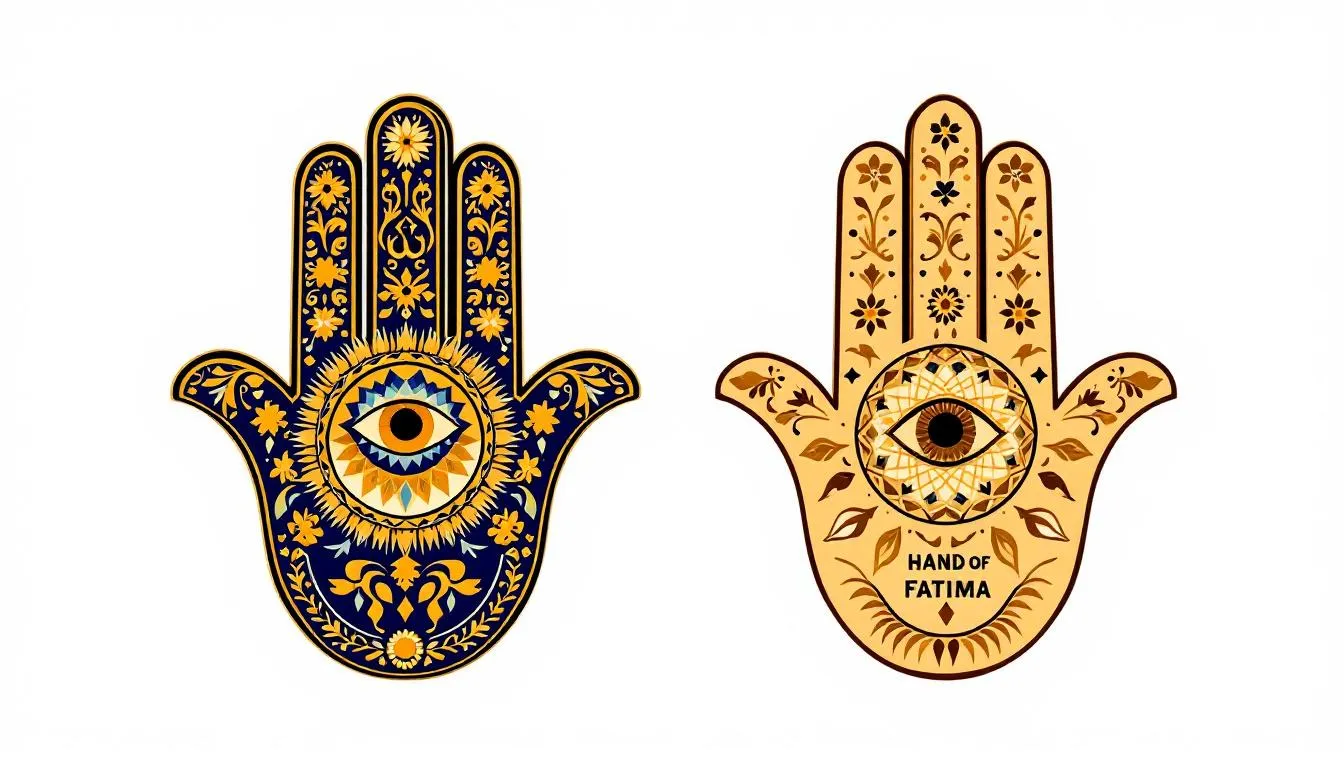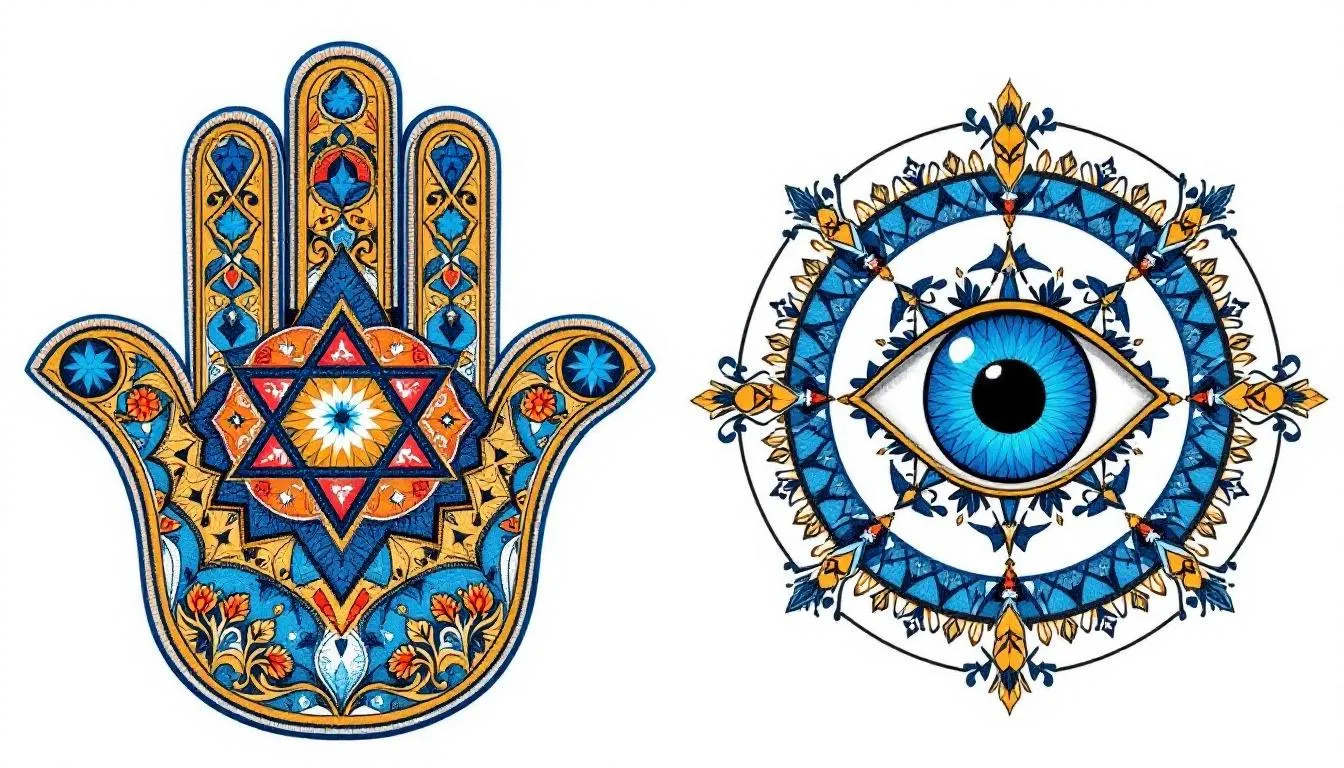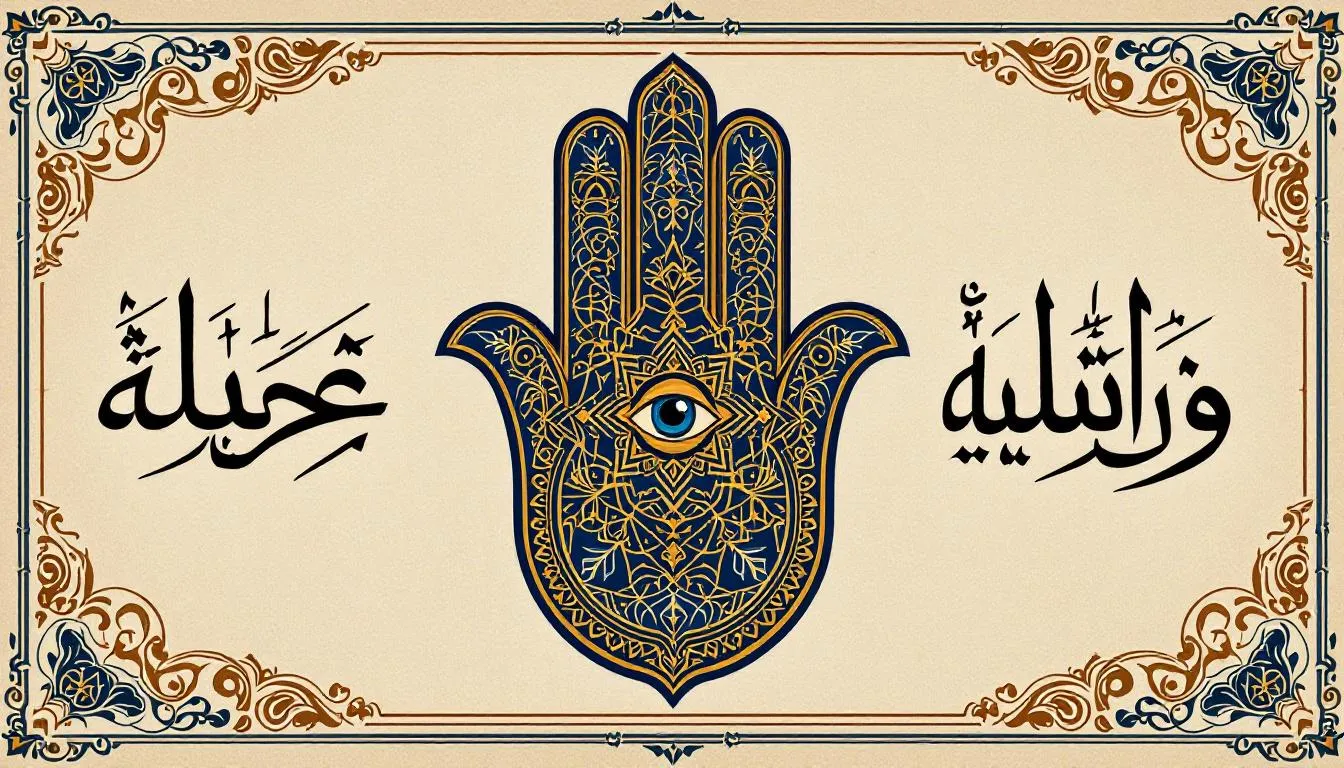Understanding the Hamsa: A Guide to Its Meaning and Significance
Introduction to the Hamsa Hand: A Jewish Symbol of Protection
The hamsa is a distinctive symbol featuring an eye embedded in the palm of an open hand, widely recognized in Jewish art and amulets for its protective qualities against the evil eye. This ancient emblem, often called the hamsa hand or hamesh hand, symbolizes the hand of God and serves as a powerful talisman designed to ward off bad luck. Within the Jewish religion, the hamsa is revered for its ability to bring good fortune, prosperity, and peace to those who possess it. In Jewish tradition, the hamsa is sometimes illustrated alongside the Hebrew letter 'Shin', representing one of God's holy names.
Originating from the Middle East, the hamsa is deeply rooted in both Jewish and Islamic cultures. The term “hamsa” itself derives from the Arabic word for “five,” referring to the five fingers of the human hand, which are central to the symbol’s design and meaning. The five fingers also hold spiritual significance, reminding wearers of the five senses and their connection to divine praise. The hamsa is a palm-shaped amulet popular throughout North Africa and the Middle East, commonly used in jewelry and wall hangings.
The hamsa pendant has become a popular decorative element in jewelry and art, often featuring an eye symbol at its center. This eye symbol is believed to protect against the evil eye—a malevolent glare thought to cause harm or misfortune. The hamsa is often depicted in two main styles: stylized hands with two symmetrical thumbs or more naturalistic hand shapes, adding to its aesthetic and cultural diversity. Hamsa hand motifs can be carved in metals like silver and gold or formed from other materials, commonly seen in jewelry. As a charm, the hamsa hand is cherished not only for its aesthetic appeal but also for its spiritual power to protect, bring luck, and promote well-being.
Origins and History of the Hamsa Hand and the Hand of Fatima

The origins of the hamsa are rich and complex, with scholars debating its precise beginnings. It is linked to various traditions, including Jewish, Christian, Islamic, and even pagan fertility symbols. While the exact time of origin remains unknown, the hamsa’s roots trace back to the ancient Middle East, where it was initially used as a protective symbol associated with a female deity. In Mesopotamia, it was connected to the goddess Inanna/Ishtar, highlighting its ancient and diverse heritage. The hand-shaped amulet representing goddesses also appears in ancient Egypt and Carthage, notably associated with Tanit.
The Arabic word “khamsa,” meaning “five,” connects the symbol to the five fingers of the hand and the five pillars of Islam, underscoring its spiritual and cultural significance. Early depictions of the open hand can be found in Paleolithic art and in the iconography of several ancient cultures, which influenced the hamsa’s development in Jewish and Islamic traditions. The hamsa also reflects the historical connection and cultural exchange between Jewish and Muslim communities in the medieval Iberian Peninsula, further enriching its significance.
In Islamic culture, the hamsa is also known as the hand of Fatima, named after Fatima, the daughter of Prophet Mohammed. In Jewish culture, it is referred to as the hand of Miriam, Moses’ sister, highlighting the symbol’s importance in both religions. Among Christians, the hamsa is recognized as the Hand of Mary, further emphasizing its role as a bearer of good fortune across different faiths. These associations emphasize the hamsa’s role as a bridge between faiths and cultures, embodying shared values of protection and divine blessing.
The Hamsa and the Evil Eye: Symbolism and Meaning in Jewish Symbolism

At its core, the hamsa symbolizes protection, blessings, power, and strength, particularly against the evil eye. It is widely believed to bring good luck, prosperity, and health to its bearer. The representation of the five fingers in the hamsa also reflects the five senses, serving as a reminder to praise God through all aspects of human experience. Additionally, in Buddhism and Hinduism, the hamsa symbolizes the five elements: earth, fire, water, air, and ether.
In Jewish texts and art, the hamsa often appears as a symbol of divine guidance, linking it to the broader themes of faith and spirituality. Additionally, the hamsa symbolizes peace, referencing the five pillars of Islam and the Torah, which are foundational to Islamic and Jewish religions, respectively. In Kabbalistic teachings, the hamsa is often seen as the Hand of God, further deepening its spiritual significance. This dual significance makes the hamsa a unique charm that wards off evil while inviting blessings and good fortune.
While the meaning of the hamsa can vary depending on cultural context, its essential purpose remains consistent: to protect and bring luck. Whether used in jewelry, amulets, or decorative art, the hamsa is believed to possess the power to shield individuals from evil forces and enhance their prosperity in life.
The Hamsa in the Middle East: Cultural Significance and Shared Heritage

The hamsa holds a prominent place in Middle Eastern culture, where it is commonly seen in jewelry, art, and various decorative elements. Across the region, it is widely regarded as a symbol that brings good luck and protection, making it a cherished emblem for many. The hamsa is commonly found on necklaces, keychains, paintings, sculptures, wall hangings, and baby carriages as amulets. Jewelry items featuring hamsas can be found in Judaica stores, online marketplaces like Etsy, and other commercial retailers.
In both Jewish and Islamic cultures, the hamsa is more than just an ornamental motif; it represents a shared heritage and common spiritual beliefs. Its presence in art and literature underscores its role as a symbol of protection and good fortune. Moreover, the hamsa serves as a symbol of unity and peace, reflecting the intertwined histories and cultural connections between Jews and Muslims in the Middle East. Mixed-culture families use the hamsa to represent unity and shared identity. The hamsa has also been adopted as a symbol of peace by activists for Middle Eastern reconciliation.
In Israel, the hamsa is particularly popular and frequently used in necklaces, pendants, and home decorations. Here, it is embraced not only as a Jewish symbol but also as a representation of cultural identity and spiritual protection. The hamsa’s significance extends beyond religious boundaries, embodying the rich diversity and historical depth of the Middle Eastern world.
Contemporary Use and Significance of the Hamsa Hand and the Hand of God
In recent years, the hamsa has experienced a resurgence in popularity around the world. Many people now wear hamsa jewelry, such as necklaces and pendants, or display hamsa decorations in their homes to harness its protective qualities. This renewed interest reflects a broader appreciation for the symbol’s cultural, spiritual, and artistic value. Many women across the Middle East own at least one piece of hamsa jewelry, reflecting its cultural significance.
Today, the hamsa features prominently in contemporary art and design, appearing on clothing, accessories, and home decor items. Its association with good luck, prosperity, and protection resonates with diverse audiences, including Jewish, Islamic, and Christian communities. The hamsa has transcended its traditional roots to become a universal emblem of charm and defense against evil.
For many, the hamsa provides a sense of comfort and security in an unpredictable world. It remains a powerful and enduring symbol, inspiring people to seek peace, protection, and prosperity. As the hamsa continues to evolve in meaning and use, it maintains its role as a cherished amulet that bridges cultures and brings blessings to life. Hamsa jewelry is often given as gifts for various occasions, such as housewarming, Bat Mitzvahs, and birthdays.
Frequently Asked Questions About the Hamsa
What does the hamsa symbolize?
The hamsa symbolizes protection, good fortune, and divine blessings. It is widely recognized as a talisman that wards off the evil eye and negative energies. In Jewish tradition, it represents the Hand of God and is often associated with the Hebrew letter 'Shin,' one of God's holy names. In Islamic culture, it is known as the Hand of Fatima, symbolizing faith and protection. The five fingers also represent the five senses, encouraging praise and mindfulness.
Where does the hamsa originate from?
The hamsa has ancient origins tracing back to the Middle East, with roots in Mesopotamian, Egyptian, and Phoenician cultures. It was originally associated with female deities such as the goddess Inanna/Ishtar and the lunar goddess Tanit. Over time, it was adopted and adapted by Jewish, Islamic, and Christian traditions, becoming a shared symbol of protection and good luck.
Why is the hamsa associated with the number five?
The number five holds spiritual significance in both Jewish and Islamic traditions. In Judaism, it represents the five books of the Torah and the five senses. In Islam, it symbolizes the Five Pillars of Islam, which are the foundation of Muslim faith and practice. The five fingers of the hamsa hand embody these important spiritual concepts, reinforcing its protective and sacred qualities.
How is the hamsa used in jewelry and art?
The hamsa is commonly featured in jewelry such as necklaces, bracelets, earrings, and pendants, often crafted from silver, gold, or other materials. It is also a popular decorative element in wall hangings, sculptures, keychains, and home decor. The eye symbol frequently incorporated in hamsa designs enhances its protective power against the evil eye. Wearing or displaying hamsa items is believed to bring luck, health, and prosperity.
Can the hamsa be used by people of different faiths?
Yes, the hamsa is embraced by people of various religious and cultural backgrounds, including Jews, Muslims, and Christians. It serves as a unifying symbol of protection and good fortune that transcends religious boundaries. Many families with mixed Jewish and Islamic heritage use the hamsa to represent unity and shared values.
What is the difference between the Hand of Fatima and the Hand of Miriam?
The Hand of Fatima refers to the hamsa in Islamic tradition, named after Fatima, the daughter of the Prophet Mohammed. The Hand of Miriam is the Jewish interpretation, named after Miriam, the sister of Moses. Both versions of the hamsa serve similar purposes as protective amulets and symbols of faith, reflecting the cultural and religious contexts in which they are used.
How should the hamsa be displayed for protection or good luck?
The hamsa can be displayed with the fingers pointing upwards or downwards. Fingers pointing upwards are believed to offer protection and ward off evil, while fingers pointing downwards are thought to attract good luck and blessings. It is often hung in homes, worn as jewelry, or placed in cars and workplaces to harness its positive energy.
Is wearing a hamsa considered offensive in any culture?
Generally, wearing a hamsa is not considered offensive and is widely accepted as a symbol of protection and good fortune. However, it is important to respect its cultural and religious significance, especially when worn by those outside of the traditions that hold it sacred. Understanding and honoring its meaning helps ensure respectful use.
How has the hamsa evolved in modern times?
In recent years, the hamsa has gained popularity worldwide as both a spiritual symbol and a fashionable accessory. It appears in contemporary art, clothing, and home decor, often embraced for its universal message of protection and peace. Activists for peace in the Middle East also use the hamsa as a symbol of unity and reconciliation between cultures.
Where can I buy authentic hamsa jewelry or decor?
Authentic hamsa jewelry and decor can be found in Judaica stores, Middle Eastern markets, and reputable online retailers. When purchasing, look for quality materials and craftsmanship. Many artisans create unique hamsa pieces that honor traditional designs while offering modern interpretations.

 https://sarasbeads.co.uk
https://sarasbeads.co.uk
Leave a comment